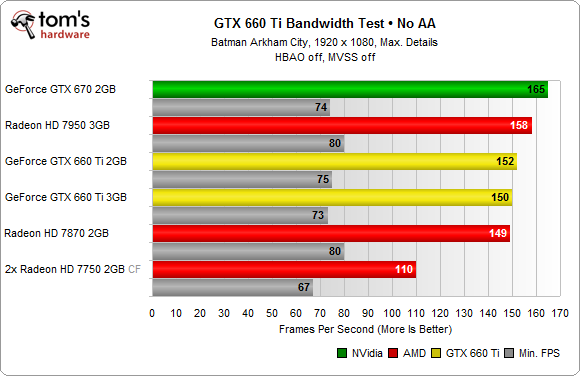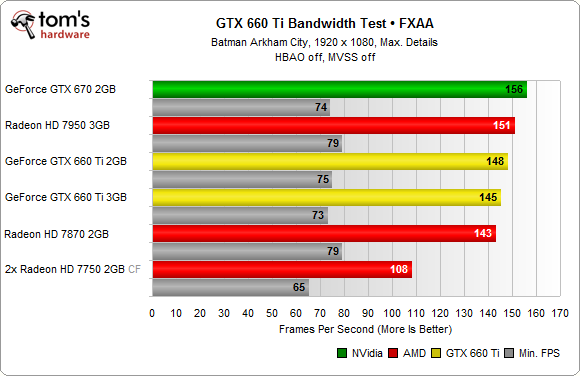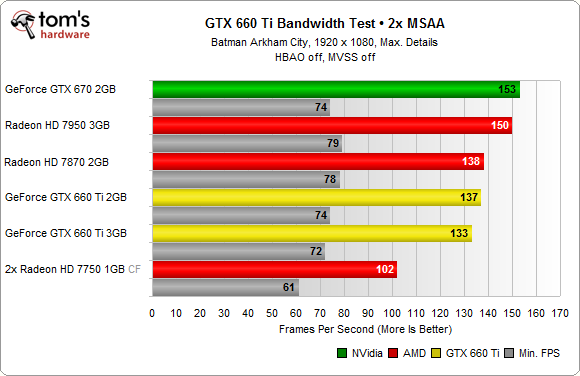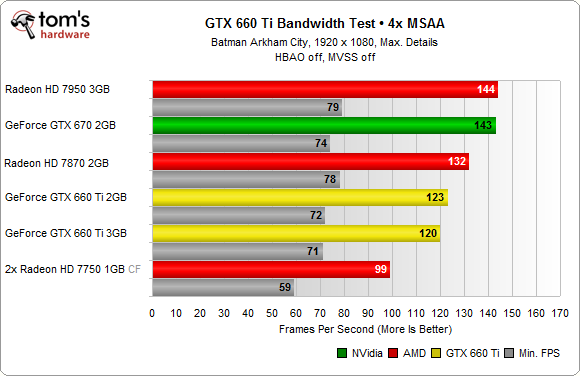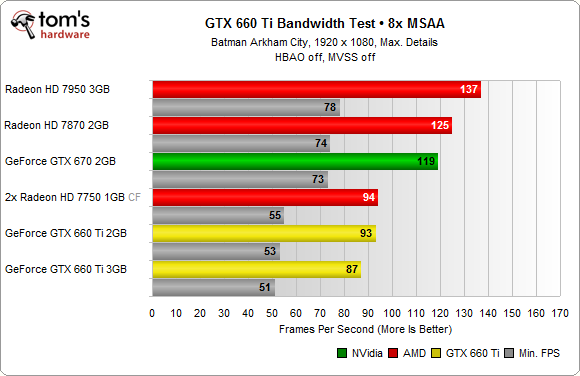Seven GeForce GTX 660 Ti Cards: Exploring Memory Bandwidth
Seven GeForce GTX 660 Tis landed in our lab. Today, we're benchmarking them, measuring their noise and temperatures, and conducting a more in-depth analysis of the impact a 192-bit memory interface has on performance. The results are enlightening!
Testing For Memory Interface Limitations: 1920x1080
Our first comparison benchmark doesn't employ any MSAA, but instead is run with FXAA enabled. The finishing order goes: GeForce GTX 670, Radeon HD 7950, GeForce GTX 660 Ti, and Radeon HD 7870.
The two Radeon HD 7750s fell into last place by quite a bit, but they still performed well enough considering power consumption less than 100 W, combined. Together, they cost about $220.
It’s interesting that the 2 GB GeForce GTX 660 Ti consistently beats the 3 GB model. So far, it looks like 3 GB of GDDR5 are too much for the 192-bit interface to handle efficiently.
The results start changing as soon as we apply 2x MSAA. The GeForce GTX 670 and Radeon HD 7950 are still on top, but the Radeon HD 7870 now beats Nvidia's GeForce GTX 660 Ti.
With 4x MSAA applied, the Radeon HD 7950 passes Nvidia's GeForce GTX 670, putting AMD in the lead in both segments. Of course, we pushed things even further, though.
Nvidia’s GeForce cards simply do not do well with 8x MSAA applied. The Radeon HD 7950 and Radeon HD 7870 not only beat their competition, but AMD's Radeon HD 7870 even beats the GeForce GTX 670.
The GeForce GTX 660 Ti can’t even keep up with two passively-cooled Radeon HD 7750s.
Get Tom's Hardware's best news and in-depth reviews, straight to your inbox.
We’d also like to say a few words about minimum frame rates in this benchmark. Nvidia’s GeForce cards lose the race big time, no matter what anti-aliasing settings we use. Subjectively, a single GeForce GTX 660 Ti under the effects of 8x MSAA is worse than the already-bad CrossFire setup. That's right: Nvidia's stuttering under those settings is more annoying than the micro-stuttering typical of many CrossFire arrays. And this is in spite of our efforts to pick settings that yield playable frame rates on all cards at every setting. We really can’t recommend Nvidia's GeForce GTX 660 Ti if you plan to use 4x or 8x MSAA; even two Radeon HD 7750s are a better choice.
Current page: Testing For Memory Interface Limitations: 1920x1080
Prev Page Testing For Memory Interface Limitations Next Page Testing For Memory Interface Limitations: 2560x1440
Igor Wallossek wrote a wide variety of hardware articles for Tom's Hardware, with a strong focus on technical analysis and in-depth reviews. His contributions have spanned a broad spectrum of PC components, including GPUs, CPUs, workstations, and PC builds. His insightful articles provide readers with detailed knowledge to make informed decisions in the ever-evolving tech landscape
-
scotthulbs I'd Like to know which 2GB model 660ti you used in this comparison? I would like to see how if perhaps the Zotac memory overclock has much of an effect on performance. If you used the Zotac in this comparison that may very well be the reason it outperforms the 3GB Galaxy card? Maybe run this same test overclocking the memory, it seems as though the 660ti with its memory overclocked can nearly reach GTX670 Bandwidth. I'd like to see how much that helps overcome the narrow bus.Reply -
mayankleoboy1 The problem with wider memory interface is that it exponentially increases the chip's die-size. Hence, cost per wafer and power consumption will increase a lot.Reply
IMO both AMD and Nvidia should use the XDR2 memory in the next series of cards. That would give the same bandwidth at half the interface size. -
iknowhowtofixitThis review reinforces what I have been saying for weeks. The GTX 660Ti is overpriced at $300. Since you can easily find a HD7950 for $300 or less after rebates, it makes the 660TI irrelevant. To me, the 660Ti needs to be $60-$75 cheaper before it can achieve bang for the buck status.it is because of the 660ti that the 7950 prices dropped to $300 or less with MIR: so tell me how irrelevant they are now?Reply
-
ahrensy For the Batman Arkham City tests on the 670 and 660ti, was the PhysX setting set to Off, Low or High?Reply -
EzioAs Reply9537131 said:it is because of the 660ti that the 7950 prices dropped to $300 or less with MIR: so tell me how irrelevant they are now?
The 7950 has been our for months now compared to the 660ti and the price drop happens before the release of the 660ti. Nvidia should really have predicted that the 7950 prices should come down even more so it makes almost no sense that they release the 660ti at $300.
The 7870 performs just slightly slower compared to the 660ti but beats it once you crank up the AA really high and it costs $50 less. On the other hand the 7950 is overall faster than the 660ti and even surpass the the $60+ 670 once you crank the AA really high as well. For the 660ti to sell, Nvidia should really lower it to $260 imo.....or they could just rely on fanboys -
Reply9537133 said:The 7950 has been our for months now compared to the 660ti and the price drop happens before the release of the 660ti.
AMD cuts HD 7000 series price even furtherTuesday, 21 August 2012 08:57 (after the 660ti release)
AMD has already dropped the HD 7970 from US $479 to US $429, HD 7950 from US $399 to US $349 and the HD 7870 down from US $349 to US $299. The new price cut skips the HD 7970 graphics card but includes the HD 7950, HD 7870 as well as the 1 and 2GB versions of the HD 7850.
The most important is probably the price cut for the 3GB HD 7950 which battles it out with Nvidia's recently released GTX 660 Ti. The HD 7950 3GB is, according to the report, will receive a US $30 price cut placing it at US $320. The HD 7870 2GB graphics card got another US $50 price cut pushing it down to US $250 which probably makes it one of the most interesting mid-range graphics cards on the market.
cheers! :) -
FormatC Reply
PhysX was off, because it affects the overall performance. PhysX is dead - ok, not quite, but almost ;)9537132 said:For the Batman Arkham City tests on the 670 and 660ti, was the PhysX setting set to Off, Low or High?
-
EzioAs Reply9537134 said:AMD cuts HD 7000 series price even furtherTuesday, 21 August 2012 08:57 (after the 660ti release)
AMD has already dropped the HD 7970 from US $479 to US $429, HD 7950 from US $399 to US $349 and the HD 7870 down from US $349 to US $299. The new price cut skips the HD 7970 graphics card but includes the HD 7950, HD 7870 as well as the 1 and 2GB versions of the HD 7850.
The most important is probably the price cut for the 3GB HD 7950 which battles it out with Nvidia's recently released GTX 660 Ti. The HD 7950 3GB is, according to the report, will receive a US $30 price cut placing it at US $320. The HD 7870 2GB graphics card got another US $50 price cut pushing it down to US $250 which probably makes it one of the most interesting mid-range graphics cards on the market.
cheers! :)
If you check the price of the 7950s before this news at most online retailer (Newegg, NCIX), you'll know that the price drop happens already although the official news from AMD was a couple of weeks later -
Reply
now you are talking complete nonsense unless you do not understand there were two price drops and the latter of which is because of the 660ti; as the article stated.so you want to see pricing history . . :)9537136 said:If you check the price of the 7950s before this news at most online retailer (Newegg, NCIX), you'll know that the price drop happens already although the official news from AMD was a couple of weeks later
Sapphire Radeon HD 7950 3GB Video Card
now how much sense does it make to drop prices and not tell anyone?
:pfff:
